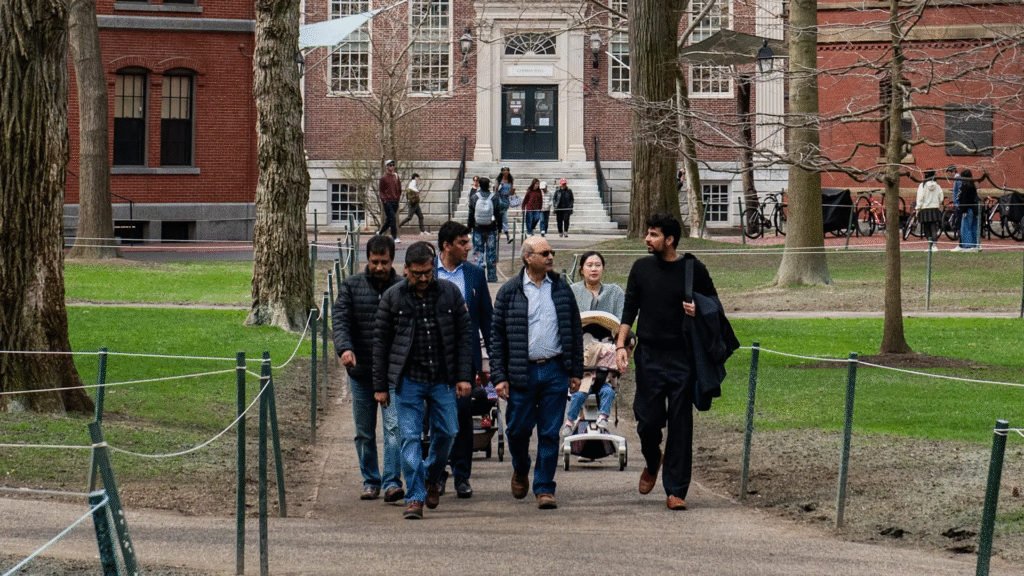Why U.S. Universities Depend on International Students
The Trump administration revoked Harvard University’s ability to enroll international students on May 23, 2025. This decision, led by Homeland Security Secretary Kristi Noem, targeted Harvard’s Student and Exchange Visitor Program (SEVP) certification.

It’s seen as retaliation for Harvard’s refusal to comply with White House demands on admissions, hiring, and protest records. A federal judge temporarily blocked the ban on May 24, 2025, after Harvard sued, calling it unconstitutional. Other universities now fear similar actions, viewing the move as a threat to their autonomy and finances.
Why Harvard Was Targeted
The conflict began in April 2025 when the Trump administration demanded Harvard provide records of foreign students’ protest activities over five years.
Harvard resisted, citing privacy and academic freedom. The administration accused Harvard of fostering antisemitism and ties to the Chinese Communist Party. Earlier, $2.2 billion in federal funding was frozen, and Harvard’s tax-exempt status was threatened.
Harvard’s lawsuit against these demands made it a prime target. The administration’s broader agenda aims to align universities with its ideological goals, escalating tensions.
Reason for the Crackdown
The Trump administration claims Harvard failed to address antisemitism and “pro-terrorist” conduct on campus. It demanded changes to hiring, admissions, and teaching practices.

Noem’s letter to Harvard cited “illegal and violent” activities by foreign students as justification. Critics argue this is a pretext to control elite universities perceived as liberal strongholds. The move aligns with Trump’s campaign against diversity, equity, and inclusion (DEI) programs and pro-Palestine protests. Other universities, like Columbia, faced similar pressure to comply or lose funding.
Impact on International Students
Harvard’s 6,793 international students, 27.2% of its 2024-25 enrollment, face uncertainty. Current students must transfer to other schools or risk losing legal status. Aspiring students, like Jared from Australia, are in limbo, unable to secure visas.

Chinese students canceled flights home, fearing deportation. A Ukrainian freshman delayed returning to her war-torn country, unsure of reentry. The ban threatens research, as 38% of Harvard’s PhD students are international. Panic spread across campus, with students seeking legal advice.
How Universities Rely on International Students
International students are a financial lifeline for U.S. universities. They often pay full tuition, unlike domestic students who may receive aid. At Harvard, international tuition subsidizes need-based aid for others. In 2024, international students contributed $46.9 billion to the U.S. economy, supporting 459,000 jobs.
Harvard’s sports teams, like men’s squash and women’s soccer, rely heavily on international talent. Losing these students could devastate budgets, research, and athletic programs. Other universities fear similar financial hits if targeted.
Comparison: U.S. vs. International Students
International students make up about 6% of U.S. college enrollment but are vital to elite institutions. At Harvard, they’re 27.2% of students, compared to 73.8% domestic. International students pay higher tuition—often $60,000-$80,000 annually—without federal aid eligibility.
U.S. students access grants, loans, and scholarships, reducing their costs. Internationals bring diverse perspectives, enriching academic debate, while U.S. students often drive local engagement. Losing international students could shift campus dynamics, reducing global appeal and research output.
Universities’ Response and Future Concerns
Harvard sued the Trump administration, winning a temporary restraining order. It called the ban a “blatant violation” of free speech. Other universities, like Columbia, are on edge, fearing copycat policies.
College leaders worry Trump may use visa restrictions to force compliance on campus policies. The threat of funding cuts and tax-exempt status revocation looms large. Universities are offering legal support and discouraging international students from traveling abroad. A full impact assessment awaits fall 2025 enrollment data.
Trump administration
The Trump administration’s decision to block Harvard University from enrolling international students has sent shockwaves through U.S. higher education.
Announced on May 23, 2025, the move revoked Harvard’s SEVP certification, essential for hosting students on F-1 and J-1 visas. This action, led by Homeland Security Secretary Kristi Noem, was framed as a response to Harvard’s alleged failure to curb antisemitism and comply with demands for protest records.
A federal judge issued a temporary restraining order on May 24, 2025, after Harvard filed a 72-page lawsuit, arguing the ban violates the First Amendment and threatens its mission. The ruling provides temporary relief, but universities nationwide fear they could be next, viewing the move as a broader attack on academic autonomy.
Geopolitics
The roots of this conflict trace back to April 2025, when the Trump administration began targeting Harvard, the nation’s oldest and wealthiest university.
The Department of Homeland Security demanded detailed records of foreign students’ activities, particularly protests, over the past five years. Harvard, citing privacy concerns and academic freedom, resisted. The administration accused the university of fostering antisemitism, collaborating with the Chinese Communist Party, and tolerating “pro-terrorist” conduct.
Earlier actions included freezing $2.2 billion in federal grants and threatening Harvard’s tax-exempt status. Harvard’s lawsuit against these measures made it a focal point for Trump’s campaign to reshape higher education. Other universities, like Columbia, faced similar pressure, with Columbia agreeing to some demands to restore $400 million in funding.
The stated reason for the ban centers on allegations of Harvard’s failure to address antisemitism and comply with federal demands. Noem’s letter to Harvard cited “illegal and violent” activities by non-immigrant students, tying the revocation to a failure to meet a federal law requiring disclosure of disciplinary actions.
The administration’s broader agenda appears to target elite universities perceived as liberal, with demands to overhaul admissions, hiring, and DEI policies.
Why U.S. Universities Depend on International Students?
Trump’s executive order on campus free speech in March 2025, prompted by pro-Palestine protests, set the stage. Critics, including Harvard, argue these actions are politically motivated, using antisemitism as a pretext to control academic institutions. Noem’s warning that other universities could face similar consequences heightened fears.
For Harvard’s 6,793 international students—27.2% of its 2024-25 enrollment—the ban created immediate chaos. Current students were told to transfer or risk losing legal status, potentially facing deportation. Aspiring students, like Jared from Australia, who was preparing to move 9,000 miles to Boston, now face uncertainty.
Chinese students canceled summer travel plans, fearing Immigration and Customs Enforcement (ICE) actions.
A Ukrainian freshman delayed returning to her displaced family, unsure if she could reenter the U.S. International students, critical to research (38% of PhD students), described “mass panic” on campus. Town halls and chat groups overflowed with anxious students seeking guidance.
International students are a financial and cultural cornerstone for U.S. universities. They typically pay full tuition, often $60,000-$80,000 annually, without access to federal aid, subsidizing domestic students’ financial aid. In 2024, they contributed $46.9 billion to the U.S. economy, supporting 459,000 jobs, according to NAFSA.
At Harvard, international tuition supports need-based aid programs. Athletically, international students dominate teams like men’s squash (10 of 13 players) and women’s soccer.
Research programs, especially in STEM, rely on international PhD students. Losing them could cripple budgets, diminish global prestige, and disrupt campus diversity. Other universities, dependent on similar revenue, fear financial fallout if targeted.
Comparing U.S. and international students highlights their distinct roles. International students, about 6% of total U.S. college enrollment, make up 27.2% at Harvard, compared to 73.8% domestic students. Internationals pay higher tuition and lack access to federal grants or loans, unlike U.S. students who benefit from scholarships and aid.
International students bring global perspectives, enhancing academic discourse, while U.S. students often anchor community engagement. The loss of international students could reduce diversity, weaken research, and shift campus culture, impacting universities’ global rankings.
Universities are responding with urgency. Harvard’s lawsuit secured a temporary block, with the university vowing to protect its 7,000+ visa holders. It called the ban “unlawful” and a threat to its mission.
Other institutions, like Columbia and Cornell, are bracing for similar actions, offering legal support and advising students against international travel. College leaders fear Trump’s use of visa restrictions as leverage to enforce ideological conformity. The threat of funding cuts and tax-exempt status revocation remains.
A clearer picture of the impact will emerge with fall 2025 enrollment data, but the higher education sector is on high alert.

